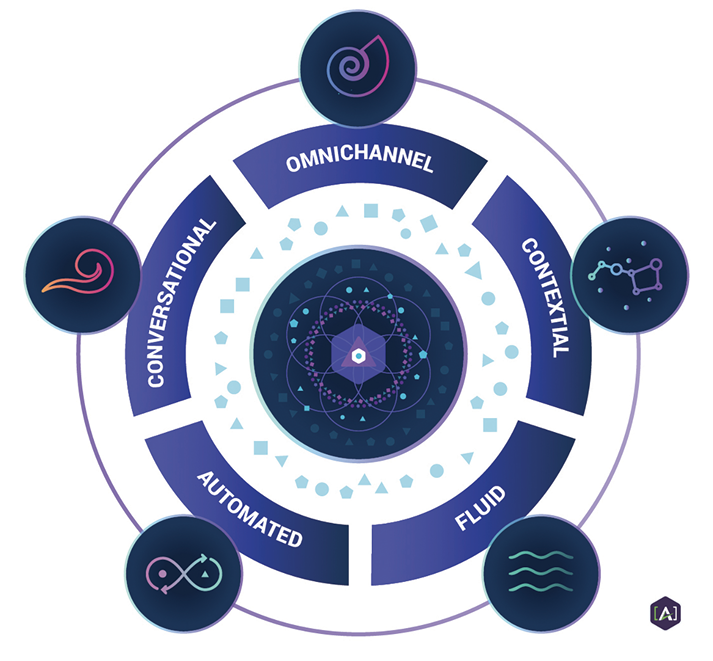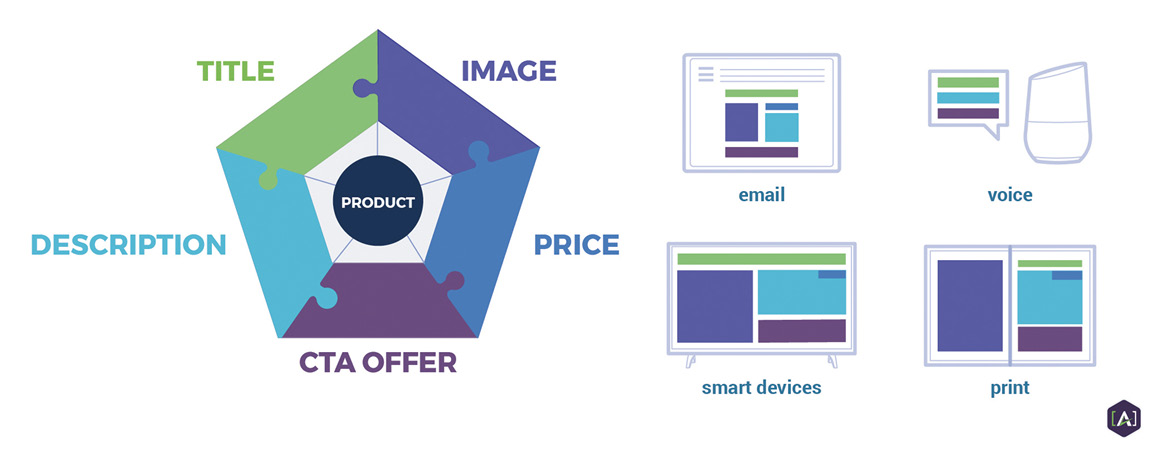By Cruce Saunders
 Publishers face many challenges creating a new operating model and orchestration approach for dynamic omnichannel content. This column addresses the changing content ecosystem and the evolving dynamics in the space. Questions, suggestions, or feedback? Email editorial@simplea.com.
Publishers face many challenges creating a new operating model and orchestration approach for dynamic omnichannel content. This column addresses the changing content ecosystem and the evolving dynamics in the space. Questions, suggestions, or feedback? Email editorial@simplea.com.
The “next generation” of customer experiences is already here, but it is unevenly distributed in the way that the future often shows itself. Customer interactions get more intelligent, responsive, and personalized every month. The organizations leading the way are intentionally creating “intelligent customer experiences.”
What is intelligent customer experience?
An intelligent customer experiences (ICX) is a uniquely assembled interaction between an organization and a customer in which the content responds to the customer’s individual context. With ICX, organizations automatically form adaptive relationships by listening to customer data and responding with contextually relevant content in real time. These new-era experiences deliver meaningful and useful content across channels, reducing the manual effort and transaction friction for consumers.
Intelligent customer experiences have five characteristics, as shown in figure 1:

- Omnichannel: Assembling content modules into orchestrated, unique customer experiences across multiple channels, platforms, and devices
- Contextual: Listening to and understanding a customer’s context and making that customer data available to real-time sessions. Bringing together relevant modular content from a content pool to meet customers in their required formats and views
- Fluid: Flowing across a complete content supply chain, customer experience (CX), and martech software stack, and into multiple interfaces and renderings with minimal rework
- Automated: Responding using conditional logic to facilitate instant and long-term customer journeys without human intervention or connecting with robot consumers of structured data
- Conversational: Connecting with customers through intent and response interactions—including chatbots and voice interfaces—facilitated by a combination of human and machine intelligence
To get there, we need to engineer here
To achieve the next generation of customer experience, content must first be available for assembly.
Not every content interaction needs to be dynamically assembled, nor does every customer experience need to be “intelligent.” It’s okay for some content to sit in big chunky fields published on traditional pages. Books are wonderful and should always exist. Compiled digital renderings (such as PDFs) serve a useful purpose. Highly designed, image-laden, pixel-perfect web interfaces are not going away, but more and more hybrid views on our content can—and should—be assembled from components.
Intelligent content cannot reasonably be separated from intelligent customer experience. The essential ingredient to all customer experience is content, thus content problems impact customer experience. More and more, modern customer experiences rely on structured, intelligent content.
Producing and maintaining intelligent content is directly derived from the practice of content engineering. The foundation for ICX is people, process, and technology purposefully aligned and intentionally using standard content and semantic structures for translation between roles and systems.
Not only is the engineering of intelligent content the key to ICX, but it is also the only sustainable way to effectively, efficiently, and productively scale authoring and publishing operations.
Paying diligent, ongoing, scientific attention to the structure, formation, assembly, and delivery of intelligent content is the domain of the content engineer.
Personalized experiences are assembled, not made
In the traditional approach employed across many digital experience teams today, content is crafted as pages or interfaces and delivered to a single endpoint. In the new era of ICX, content must perform work across more than just one page, interface, or customer interaction. We need to craft systems of content portability that content leaders can leverage to activate many experiences from one content pool.
To assemble an intelligent customer experience, we bring together modules of structured content into different representations, as shown in figure 2, so that, for example, a product and related descriptions can assemble into many variant outputs. This idea might seem like common sense, but implementations are still too rare.

First, we need to get to a basic structure for reuse. Then, beyond simpler presentation variation comes the more advanced contextual personalization of content. Personalization depends on structured content meeting real-time customer context. There are, however, some common misconceptions about what makes personalization possible.
Buying technology
Personalization is not a piece of tech. No software gets us there. Those technical solutions boasting that they can “manage and deliver content across multiple channels,” all depend on content structures and semantics, which all relies on content engineering. When we write content to a single platform, it’s stuck. Content engineers work to decouple content from systems so that systems are less constraining and restrictive to the content supply chain. Content needs to move fluidly between systems and representational states.
Hiring a pro
Personalization is not accomplished by making a single hire. No personalization guru can do much real work without structured content. We can make really intense spreadsheets of personalization characteristics and data, but unless the content can keep up with the targeting profiles and algorithms, they are all paper tigers. Hiring is only part of the answer.
Changing the process
Personalization is more than just creating a new process or changing an old one. It requires process, but process change alone misses the goal. Technology does enable reduced content supply chain friction, when that technology is architected to help, and engineering content and technology must be included in the overall program.
Personalization is an effect born from many causes across content and context, across strategy, engineering, and operations. We should not assume intelligent customer experiences will happen by pressing any one button, buying any single technology, or hiring any one person. Shortcuts lead to short impacts. This next generation of experience requires us to deliver integration across various native content sets at scale. To meet this challenge, content will be engineered and orchestrated on an entirely new level, and it requires us to work toward the whole, one part at a time. Getting there takes leadership.
Content leaders drive intelligent customer experience
Over the last two years, [A] has seen more and more professionals with a background in technical communication, content strategy, and the technical dimension of content becoming significant leaders in organizational change. We also seen content leaders taking up global portfolios as corporate Vice Presidents, like Anna Schlegel at NetApp. Introducing the practices of content strategy, content engineering, and content operations into teams takes work and perseverance, but it is happening.
The enterprise landscape keeps changing. Customer experience initiatives are taking over marketing and technical communication organizations. We see omnichannel customer experience moving from individuals’ roles into organizational structures. The wheels are in motion. Content sets will eventually be connected across a single customer journey; it’s just a matter of how and when.
Knowledgeable content professionals bring the wisdom and tactical knowledge necessary to move the conversation away from a one-dimensional discussion of tools toward a more systematic approach to content intelligence. The following are some things we can each do.
- Invest in or advocate for skill development around content engineering to grow the practice. Integrating the content engineering practice and mindset into our ecosystems will begin to improve digital process and systems.
- As a content leader, take the reins and drive the conversations around intelligent customer experience and how content intelligence activates it. Start conversations with colleagues who are excited and passionate about the future of content.
- Share knowledge by building or participating in communities focused on the future of customer experience and intelligent content skill sets. Some examples include Society for Technical Communication (STC), conferences, online forums, and the [A] Content Order, which facilitate this kind of dialogue and idea-sharing. These kinds of groups can be built within an enterprise, as can committees, communities of practice, or centers of excellence.
- Begin the foundational work to assess the current process around content and build working groups to explore the future of how content is created and consumed.
Content engineers are working every day on new solutions for improved intelligent customer experiences. Through innovation and collaboration, we are all navigating the ever-expanding ecosystem that supports intelligence.


